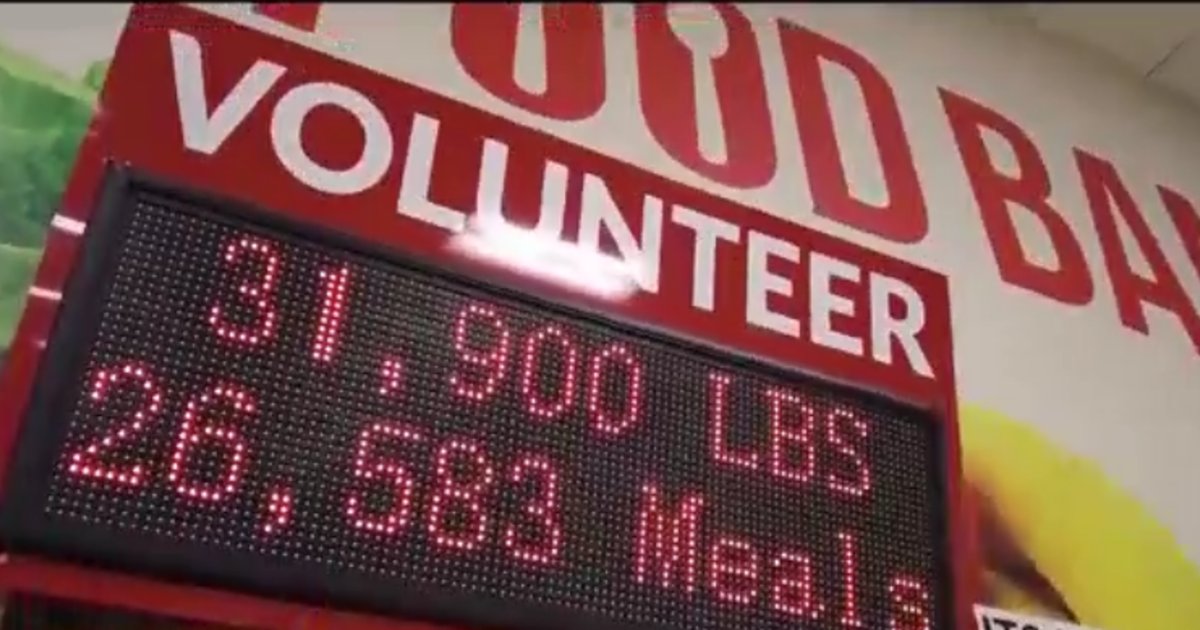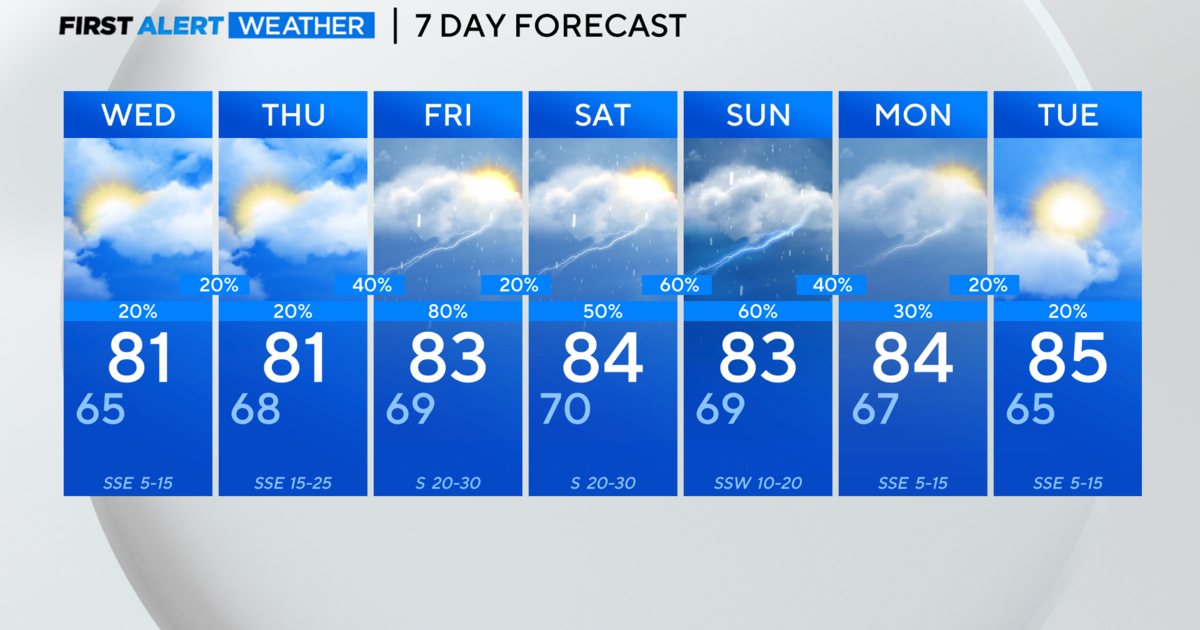I-Team: Storm Shelters Rare In North Texas Schools
FORT WORTH (CBS 11 NEWS) - Some of the most compelling images out of Moore, Oklahoma have come from the recovery of students from heavily damaged elementary schools. Those schools did not have underground shelters and, as a result, nine children died.
School officials in North Texas took absolutely no chances today. Cleburne ISD sent students home about an hour after they arrived for school. Despite the fact that there were no major weather events in Cleburne, school and city officials don't regret their decision to close.
The CBS 11 I-Team took a closer look at schools in our area, uncovering information on which districts have underground shelters, which don't and why.
Plain and simple -- It all comes down to the mighty dollar. Most school districts don't have underground safe areas or shelters because it's just too expensive to build them. Instead, they focus on severe weather plans that include hiding in hallways and teaching students to duck and cover.
"Very scary. I have family in Edmund, Oklahoma," Danae Kranerick, Keller parent, told CBS 11, the day after the Moore tornado. "So, that's why we're taking some extra precautions today."
Worried about Tuesday's North Texas weather predictions, Danae Kranerick picked up her 16-year-old son earlier than normal.
"Just more of being together as a family, if something did happen," Kranerick explained.
Keller High School doesn't have a basement or underground shelter. In fact, there's only one school in the district that has something like that.
"Ridgewood has one, below ground, they have a shelter below ground. They use some of their classrooms downstairs," Kevin Kinley, Keller ISD Safety-Security Director, noted.
But Keller ISD isn't alone; Highland Park also has just one.
"The one school that has the basement is the high school. And that's certainly limited. Again, the high school has over 2,000 students. So, the basement is not going to accommodate 2,000 students. So, it's interior hallways is the primary place where you can shelter," Dr. Dawson Orr, Highland Park ISD Superintendent said.
Both Fort Worth and Dallas ISD also tell us they have a few schools with underground capabilities. While districts like Arlington and Plano don't have a single school with an underground shelter. And they don't have any plans to build them any time soon.
"That's probably a decision that has to be left to a school board. The school board has to decide about the cost of doing that," Clint Bond, Fort Worth ISD spokesperson, told us.
Instead, school districts like Keller are focusing on taking a proactive approach. That includes more tornado drills and yearly audits on their schools.
"That's why we have an assessment team now that's assigned to our schools and that's actually looking at each school and each campus, looking at security concerns and also better ways to protect our students as far as weather is concerned," Kinley added.
Arlington ISD:
Shelter in place is the new term for what used to be called duck and cover. Each building has its own plan as to the locations within the building that are "safe" locations during severe weather. We monitor the weather closely, in conjunction with the Arlington Police Department and the National Weather Service. As severe weather approaches, students and staff report to their assigned shelter in place locations and stay there until conditions are safe.
Carrollton-Farmers Branch ISD:
In the event a tornado warning or a tornado occurs during school hours, your child's campus will implement shelter-in-place procedures to ensure your child's safety, in which all students, faculty and staff will take shelter. Therefore, we will not allow any visitors into the building and will not be able to answer any phone calls or emails until the storm has passed. Parents, please take appropriate shelter in your home or place of business in the event a tornado warning or tornado occurs. Stay tuned to your local news and forecast for updated weather information. Once the storm has passed, shelter-in-place procedures will be lifted and parents may pick up their children at that time.
Dallas ISD:
The Dallas Independent School District has a detailed Emergency Operations Plan, formulated to include district wide responses to weather-related emergencies. In the event of a tornado, each school's Campus Emergency Operations Plan will be implemented.
In addition, the district activates its Emergency Operations Center to track storms as they approach the Dallas area. The EOC communicates directly with schools regarding necessary safety measures that may need to be taken and also directs information through various means to keep parents and the general public informed. Should campuses need assistance because of damage to a building, the EOC helps get resources to appropriate personnel and students.
Students will be kept in a safe area until conditions improve and it is safe to dismiss them. Parents are encouraged to visit the district's Web site at www.dallasisd.org or call the Emergency Hotline at (972) 925-5810 for updates as they become available. Information will also be shared through Facebook and Twitter.
Our schools are required to conduct safety drills each year. The Emergency operations team recommends that schools conduct a shelter in place drill during the spring semester to prepare for tornadoes.
A limited number of schools have underground shelters—one was built with a shelter; the others are schools with classrooms that were built below ground level. Retrofitting schools to provide underground shelters for more than 158,000 students and 20,000 employees would be very expensive.
Highland Park ISD:
All our campuses are equipped with weather radios and two-way radios that enable us to communicate with safety officials from both University Park and Highland Park. We will continue to closely monitor the weather throughout the day.
If the tornado watch is upgraded to a tornado warning, our campuses will shelter in place. If that occurs, doors will be locked and staff members and students will be situated away from windows and doors, so parents and others authorized to pick up students will not be able to do so while the warning is in place. Due to the dangerous conditions during a tornado warning and because the doors will be locked, we ask that parents not come to campus until the warning is lifted. Instead, please find shelter until the dangerous conditions have passed.
If a tornado warning occurs, we will communicate with parents and staff using our emergency text and e-mail notification system. We will also send a follow-up announcement when the warning is no longer in effect and children are cleared to leave campus.
Grapevine-Colleyville ISD:
GCISD takes the responsibility of student safety very seriously and we practice regularly for a variety of situations. All schools across GCISD practice severe weather (tornado) drills a minimum of three times per year. In a severe weather, students are moved to the interior of the buildings in areas away from glass such as interior classrooms, offices or smaller rooms.
For the safety of our students and staff, all schools and facilities will be secured in a lockdown status during a severe weather event. Parents should not come to the school during a lockdown as staff will be assisting students and will not be available to let in visitors. Furthermore, we urge parents to remain in a safe location during a severe weather event for their own safety.
Keller ISD:
District campuses have conducted mandated tornado drills and campus administrators will be monitoring their severe weather radios throughout the day.
Keller ISD's Severe Weather procedures are set forth in District Administrative Regulation FFF(R3) and outlined below.
When severe weather impacts KISD campuses and facilities, the following guidelines apply:
A. Per KISD safety procedures, during severe weather conditions, students are brought inside the building and outside activities are suspended.
B. Campus administration will utilize local media, weather radio and/or internet for the most up-to-date weather information to be used to determine next steps for their campus/facility.
C. If an Outdoor Warning Siren sounds, a weather lockdown is immediately initiated. Those in portable buildings move into the school. During a weather lockdown internal/external doors are locked, movement inside is limited, and classroom instruction continues until the lockdown is lifted. Parents are allowed to check out their child during weather lockdown.
D. If a Tornado Warning has been issued and the campus is in the immediate path of a tornado per the weather resources mentioned above, students and staff will proceed to designated locations and immediately move to a duck and cover position. When a campus is in duck and cover, parents are allowed to enter the building and take cover in an interior location, but are strongly encouraged not to leave with their student until the weather threat has passed.
E. In the event of a weather lockdown, campus administration shall utilize the School Messenger System, campus email, and campus web site, and campus social media tools to notify parents.
F. Campus administration will communicate immediately and frequently with Central administration (Leadership, Media Services, and Safety and Security) to report current weather conditions and campus action steps taken through email and/or texting. The decision to shelter students and staff in a KISD facility during severe weather can be made by, but is not limited to the following KISD staff:
• Campus Principal (or designee)
• KISD Superintendent
• Deputy Superintendent
• KISD Leadership (Asst. Supt/Directors)
G. KISD Safety and Security: If a parent chooses to have their child dismissed during severe weather, the District will honor the request as long as the parent has signed a District-approved severe weather release waiver. The waiver is valid for one school year and must be submitted annually. Waiver forms are to be kept on file at the campus. Campuses will provide information about the waiver form through campus newsletters, and will provide a copy of the form to parents upon their request. Walkers will be held unless a waiver is on file.
H. Bus riders arriving at school during severe weather conditions with lightning strikes visible must remain on the bus for approximately 30 minutes after the last strike.
I. Bus riders awaiting transportation during severe weather conditions with lightning must remain in the building until it is safe for them to get on the bus.
J. All student and staff after school activities, including professional development, faculty meetings, practices, and contests at home and way will be suspended if a severe weather watch is in effect at dismissal time or goes into effect during the time of activity.
Plano ISD:
District policy CKC (local) states that principals shall conduct emergency drills to assure the orderly movement of students and personnel during severe weather. The accepted and recommended signal for these drills is a series of uninterrupted or continuous short bells. One long bell signal call is clear and students should be returned to class.
1. The principal should select an area of the building to be used for shelter by each class or section of the building. In selecting the sheltered area the principal should look for interior hallways that do not run parallel to the southwesterly direction and are located on the ground floor of the building.
If possible gymnasiums, auditoriums or other rooms with wide free-span roofs should not be used. Also, areas adjacent to a great deal of glass should not be used. It is very important that all staff members and all students know where the designated shelter area is located.
The principal should contact the building's architect in selecting the safest areas of the building. The district's director of new construction will assist you in contacting the architect.
2. The principal should designate an outside area, well away from the building and power lines, for assembly should it become necessary to evacuate the building.
3. During periods of severe weather, particularly when a tornado watch is in effect (a tornado watch occurs when weather conditions exist which make a tornado possible) specific staff members should be assigned to monitor the building's cable television and the city's early warning sirens/speakers.
Once in the sheltered area all persons should assume a protective position by kneeling on their knees and elbows with their foreheads on the floor and covering their heads with their hands. Persons in wheelchairs or other persons who are unable to assume this position should assume whatever position that affords them the most protection. It is recommended that those in wheelchairs not be removed from their wheelchairs, as this will limit their mobility.
If a tornado or other storm should hit the building, persons should remain in the sheltered area until it passes. The area should then be carefully inspected for downed electrical lines and other hazards. Before leaving, the area should be checked for injured persons. If possible, one staff member should remain with the injured while others direct the remainder to predesignated assembly areas. Once in that area, the principal should assign one staff member to insure that emergency help is summoned.
Next, the principal should have a list compiled of the students who are present, those known to be injured and left in the building and those who cannot be located.
If a tornado appears so quickly that the above action cannot be followed, all occupants should seek cover at once. For those inside the building, heavy furniture provides good protection. Interior closets also provide shelter. Once in the sheltered area, persons should assume the protective position.
4. Anyone caught outside should not attempt to run to the building unless he or she is absolutely sure to arrive before the tornado strikes. Instead, the person should take shelter by assuming the protective position on the ground. If a ditch, creek or other depression is close, the person should take shelter in it.
5. If a school bus is caught in the open when a tornado is approaching, the occupants should be escorted to a nearby ditch or other depression where they should lie face down with their hands covering their head.
6. These procedures should be practiced at the building level at least one time each semester.
It is recommended that these drills not be practiced by transportation unless permission is received from the Director of Safety and Security Services and or the Associate Superintendent for District Services.
Students are not to be exposed to danger or inclement weather for the purpose of practicing these procedures.
Also Check Out:
- 6 Dead After North Texas Tornado Outbreak
- West First Responder Posts Erratic Facebook Messages
- Duncanville Teacher On Leave After Student Viral Video Rant
- Nordstrom No Longer Tracking Customer Phones
- Severe Weather Pictures: May 15, 2013
MOST VIEWED GALLERIES
- PHOTOS: Your Pet Pictures
- PHOTOS: Dallas St. Patrick's Day Parade
- PHOTOS: Pope Francis I



